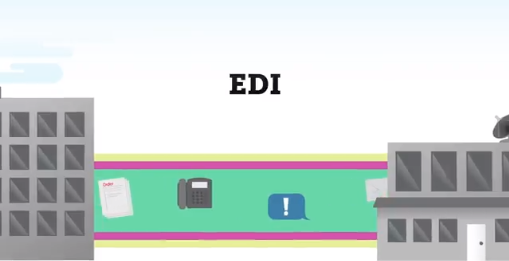Electronic Data Interchange, or EDI, has been a component of various supply chains for almost four decades. Originating with Ford Motor Company in 1983, suppliers have been receiving production schedules and/or purchase orders electronically. Soon afterward, suppliers were required to send back electronic packing slips in the form of Advance Ship Notices, or ASNs, along with electronic invoices. The longevity of EDI technology is due to its ability to dramatically lower the cost of doing business. Automotive Industry Action Group studies in the 1990s determined that the costs of manually processing a PO between customer and supplier dropped from $.75 to $1 using EDI.
Today, there are over 250 commercial EDI transaction sets, facilitating exchange of transportation, student loans, real estate appraisals, mortgages, customs and healthcare information. 70% of business commerce documents consists of the same data, entered over and over between customer and vendor. When EDI replaces the manual data entry of snail mail, fax, email or even stand-alone EDI transmissions, order processing time shortens, accuracy improves, and fulfillment shortens. Beside the ERP backbone, many supply chains leverage EDI – and more are taking a second look at RFID.
RFID itself is not “new”. Developed for commercial application in the 1990s, by the year 2000 RFID was proclaimed to be “the next big thing” – even making the bar code obsolete. However, early applications of RFID turned out to be expensive, unstable, and lacking reliable ROI. Today, RFID is finding its place. Tracking high-value assets and/or containers, capturing traceability data, managing quality control and error-proofing shipments are a few examples of the reliability and value that RFID technology can deliver.
The basic components of an RFID deployment include RFID tags/antennae, readers/portals and middleware. An RFID tag consists of a tiny chip and antenna called an integrated circuit. This tag may also be part of a barcode label that may be attached to or inserted in a product, asset or containers such as bins & pallets, for example. Some tags store static information such as a container ID value; other tags may be assigned variable information such as electronic product code, GS1 data, and so on, that can be read, tracked or appended to by RFID readers. Readers or portals are fixed or mobile network-connected devices, with antennae that send power, data and commands to the tags. Often overlooked, RFID middleware filters, manages and communicates the data between the tag and the back-end system.
EDI has been mandated by various supply chains for many years, and more companies are evaluating RFID EDI technology to streamline and error-proof their processes. What might it look like if EDI and RFID were to collaborate, and further improve a manufacturer’s operations?
Incorporating RFID within an EDI process can further eliminate manual efforts, automate processes and enhance compliance between supplier and customer, such as:
- Ensuring the right containers are loaded on the right trucks headed for customers
- Automatically printing labels and shipment documents
- Updating EDI ASN’s with verified serial shipping container codes
- Tracking containers and RTI’s
- And some day RFID tags could even generate EPCIS events to be tracked globally
Taking this idea a step further, if the customer was utilizing RFID and EDI they could receive as ASN and the data cross referenced to their Purchase Order. Upon receipt of a shipment, instead of manually scanning in and counting the order they could receive the pallets through an RFID portal and the materials would automatically be verified within their system against the PO and ASN before being entered into inventory. After this successful triple verification, their system would generate an EDI 820 payment notification.
Our industry is going to continue to evolve and new technologies will emerge. But if we’ve learned anything it’s that there are some tried and true legacy solutions that can be taken advantage of now.

